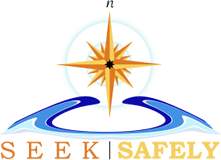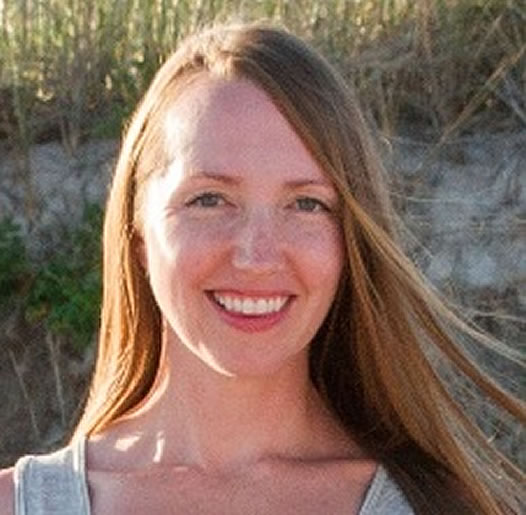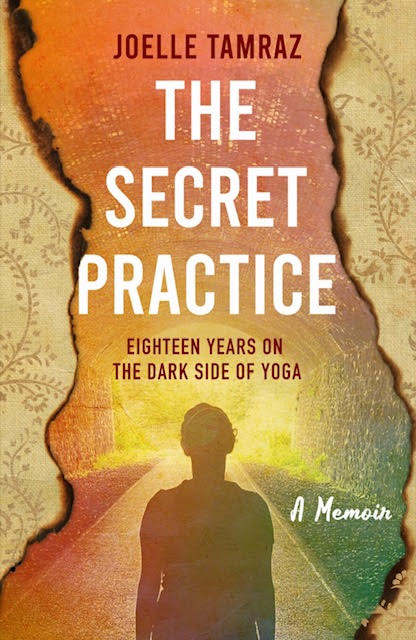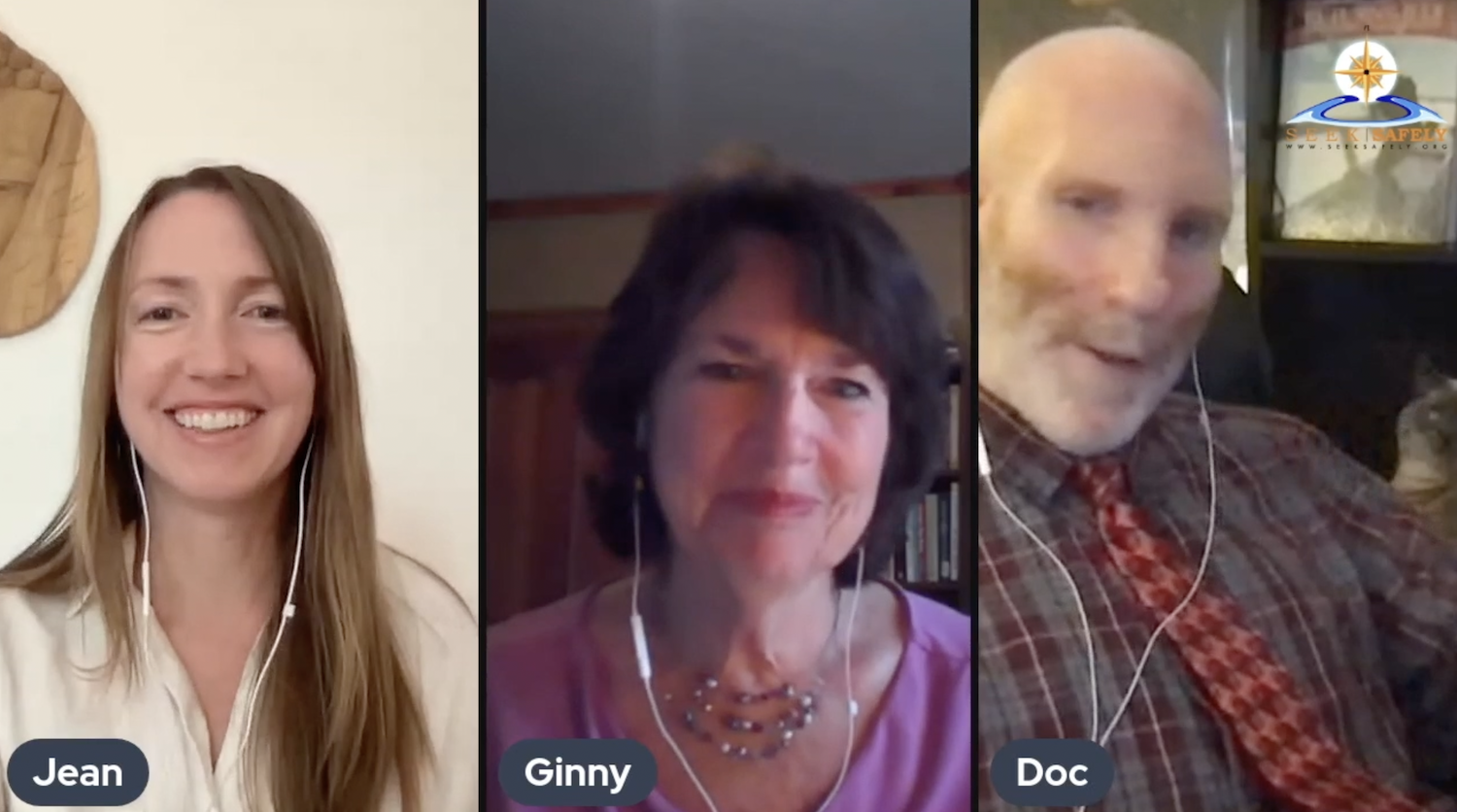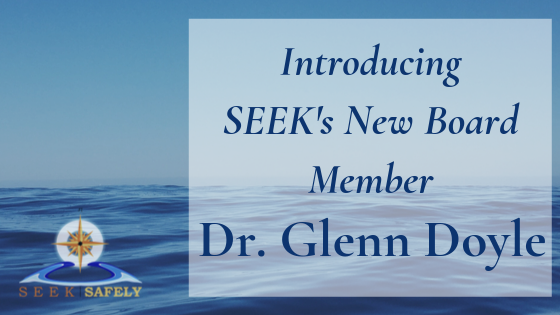
The other day, we introduced our new Board Member for SEEK Safely, Dr. Glenn Doyle. If you haven’t already, check out Part I, then come back here for more of Dr. Doyle’s story! In this second part of our interview-introduction, Dr. Doyle discusses his interest in our story and what he hopes to accomplish with SEEK and for the self-help industry as a whole.
Q: You have become something of a watchdog for self-help scammers, particularly James Ray. When did you first hear about Kirby, and/or SEEK, and why did you connect with our mission?
A: Well, I knew about James Arthur Ray before I knew about Kirby or SEEK. For a minute, he was a semi-well known figure in the self help industry— though not as well known as he imagines himself to have been.
(At least, not before Sedona.)
I stumbled across James the way a lot of people stumbled across him: he had a bestselling book out titled “Harmonic Wealth” (and he’d been in “The Secret,” and he’d been on “Oprah”). As an avid consumer of the self-help genre, not to mention an aspiring self-help teacher myself, of course I was going to read this book by Oprah’s newest personal development crush.
I read “Harmonic Wealth,” and it wasn’t bad. It’s a fairly well put together self-help book. Not all of them are.
I could see where he was recycling a lot of ideas that had been around in the self-help ecosystem for awhile, but James had put together a book that was accessible and entertaining, kind of just right for the post-“Secret” zeitgeist.
I was a fan—even though you had to acknowledge that James himself didn’t have much in the way of training.
Or credentials. Or, you know, particularly original thought. But still—good book.
I remember when I first read about Sedona. It sounded like a horrific accident—which, of course, it was.
But I also remember being dismayed, because I knew that the media was going to use the opportunity to drag self-help in general and the people who consumed self-help content through the mud.
(Which… they did.)
At the time, I had no idea what had really happened at Sedona.
I had no way of knowing that while, yes, it was an accident in that obviously no one had set out to kill or die that day… that it was James Arthur Ray’s dishonesty and negligence that had done more than just set the stage for what happened in the sweat lodge.
In my opinion, James’s arrogance and lack of discipline made that tragedy almost inevitable.
It was only after James’s release from prison put him back on the radar screen of the self help industry that I really began to understand what he was all about.
Having previously liked and kind of admired James, to see how he talked about Sedona as he attempted to rebuild his brand was really, really disheartening. Every single time he talked about it, his focus was on HIM—what HE had lost, what HE had been through.
It was as if Sedona had happened “to” him. Every time he spoke about it, he framed it as an unbelievable stroke of bad luck… that HE had to somehow learn to cope with.
And he was obviously very angry about it. He didn’t hide it well, either.
At the same time, I was noticing something about his rebranding campaign: he was putting out really, really questionable content. As in, content that lacked ANY kind of relationship to what psychological research had clearly established, on subjects such as depression, sleep, and decision making.
I could see a vulnerable seeker taking James’s advice… and digging themselves into a real hole of black and white thinking, sleep deprivation, and impulsivity. And then blaming themselves for this “expert’s” advice not working for them.
Each post from James was more disturbing, more irritating, more infuriating, than the last.
And what was more: he was kind of, sort of, starting to have some success and rebuilding his brand.
He wasn’t as well known or well regarded as before Sedona—but he was, by increments, starting to offer workshops and events again… and it started to look like he was getting some takers.
And this is where I really connect with SEEK’s mission: because I’ve come to understand that James really represents the worst about what the self-help movement can be.
He represents how dangerous it can be to confidently disseminate blatant misinformation, particularly about mental health.
He represents how exploitative it can be, particularly of people who are willing to spend money on improving their lives…and who do so in good faith, assuming that the people who develop and present self help products have done THEIR legal and ethical homework.
And that, in a roundabout sort of way, brought me to Kirby.
Kirby was someone very much like me.
She believed in self-help.
She was willing to invest time, energy, and money in improving her life.
She was willing to give a teacher like James the benefit of the doubt, on the chance that his teachings had something for her she couldn’t discover on her own.
And James’s arrogance, ignorance, and recklessness led her down a path where some of the best things about her— her willingness to risk, her willingness to trust, and her willingness to endure discomfort for the sake of growth— got her killed.
Something like that should never happen again.
Q: What do you hope to accomplish with SEEK?
A: I think SEEK is in a position to be the leading voice pushing back against exploitative figures, philosophies, and organizations in the self help movement.
I think the culture at large doesn’t really understand the self help movement, or self help consumers, very well. I think there’s a lot of stigma and misunderstanding about self help out there—which, in a way, is an extension of the stigma and misunderstanding that surrounds mental heath issues in general.
I think SEEK can be an important resource for consumers of self help.
Not just in keeping tabs on potentially problematic self help figures like James Arthur Ray—but also in educating consumers about how to pursue their personal development in ways that are safe and effective.
Because it’s not just about avoiding scam artists.
It’s also about understanding what makes for good self help.
I think the only way the stigma around self help diminishes is if the industry itself is open to scrutiny and open discussion about what works and what doesn’t.
Self help, at its best, is about empowerment and growth—and empowerment and growth, in order to be healthy and sustained, need to be all about transparency and honesty.
I think SEEK can work toward a paradigm shift in the culture that sees self help figures and organizations become some of the MOST trusted in the culture—as opposed to the least trusted.
What I want, in the end, is for SEEK to represent the gold standard when it comes to content that truly helps people distinguish between self help that will work for them… and self help that will potentially exploit them or exacerbate their problems.
I also think SEEK can play an important role in helping people get out of bad relationships with self help organizations that have already taken advantage of them.
I think there’s a not-small subset of people who do realize when their relationship with a teacher or an organization has gone sour… but who have no idea how to get out of that ecosystem, because they’ve invested so much financial and social capital in it.
Frankly, the self help industry has needed an organization like SEEK for a long time.
It’s up to us to see if anything remotely positive can come out of what happened in Sedona.
Q: Apart from your involvement with SEEK, what are some of your own professional goals?
A: My personal mission statement is “to help as many people as possible, make their lives as awesome as possible.”
I’ve spent my career working toward opportunities to positively impact more and more lives.
One of my great frustrations as a therapist is the limitations that my job imposes on me.
Working hour by hour with individuals is important and amazing on its own— but it’s a drop in the bucket, compared to the swaths of people who COULD benefit from psychology, but who can’t make it in to a therapists’ office for various reasons.
Consequently, it’s a long term goal of mine to be in the position to offer support and services to more people who need them, but who can’t readily access them.
Over the last several years, I’ve expanded the pro bono work that I and my supervisees have done in the Doyle Practice, and I’ve worked hard to establish my social media presence as a potential resource for people who are struggling.
It’s a goal of mine to eventually create and lead an organization that offers more and more such resources. In an ideal world, I’d love to see the Doyle Practice expand to a level where we could consistently offer services that meet real needs in the real world— without being at the mercy of public funding or insurance compensation.
I’m really lucky to have been able to afford and complete my professional training, and I feel that it’s on me to work to give something back.
But: none of the professional stuff means much if I’m not realistically impacting lives, in a constructive way, on a daily basis. That’s why I’m so invested in my writing and my social media presence… and why I continue to want to play a role in the positive evolution of the self help industry and community.
Q: Given your interest in becoming a self help professional yourself, what does a responsible self help industry look like to you?
A: First and foremost, there needs to be a reliable way to tell the differences between a personal development seminar and a cult.
That may sound dramatic, but I’m serious: there are self help figures out there—like James Arthur Ray—whose playbook is indistinguishable from the “brainwashing” techniques used by historically exploitative cults.
To me, a responsible self help industry produces content and products that focus on the needs of the consumer—as opposed to trying to upsell the consumer on more expensive products and services.
A responsible self help industry needs to embrace the fact that we’re not selling cars or computers here. Marketing techniques that are appropriate to many goods and services, are NOT appropriate to many self help products and services, because of our target market.
I think we need to be particularly aware of the fact that the people who are going to be most interested in our products and services are, by definition, vulnerable.
Our consumers are NOT stupid or weak—but they are likely investigating our industry in the first place because they’re looking to scratch a very personal itch. And that means they can be particularly susceptible to manipulative marketing tactics.
To me a responsible self help industry is realistic about and sensitive to this reality.
Beyond that, I want to see a self help industry that is, above all, trustworthy and honest—and which has earned a reputation for being trustworthy and honest.
One of the biggest problems with James Arthur Ray is that he got people to consume his content because he claimed credentials and life experience he just didn’t have. I want to see a self help industry where someone cannot rise to the level where James was (here looking at you, Oprah) while blatantly lying about who they are and what they know.
And above all, I want to see a self help industry that has worked hard to erase the stigma associated with self help.
A good place to start on this project would be practitioners signing the SEEK Safely Promise.
***
Thank you so much, Dr. Doyle, for joining us! We feel very lucky to have you on board with us!
For more from Dr. Doyle, check out his website and Facebook pages. You can also find him on Instagram @drglenndoyle.
